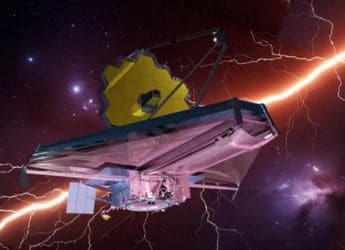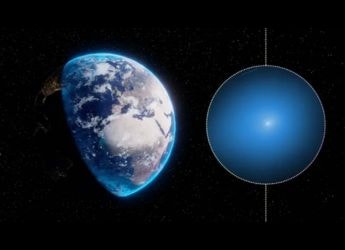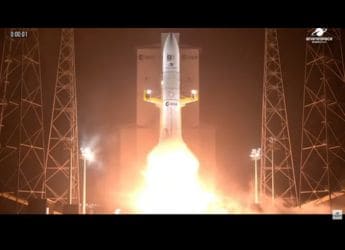- Home
- Science
- Science News
- Ancient Stars Found Near Sun Suggest Milky Way is Older Than Previously Thought
Ancient Stars Found Near Sun Suggest Milky Way is Older Than Previously Thought
A group of ancient stars found near the Sun suggests that the Milky Way's thin disk may have formed billions of years earlier than previously thought.

Photo Credit: Live Science
A new study has revealed that the Milky Way's thin disk may be much older than previously believed, thanks to the discovery of ancient stars located surprisingly close to our Sun. Researchers using data from the European Space Agency's Gaia space telescope have found that some of these stars formed less than a billion years after the Big Bang, making them more than 13 billion years old.
This discovery challenges the long-standing belief that the Milky Way's thin disk, where most stars, including the Sun, reside, formed around 8 to 10 billion years ago. Instead, the new findings suggest that the formation of this region of the Galaxy began as early as 4-5 billion years earlier than previously thought. This significant revision to the timeline could dramatically alter our understanding of the Milky Way's history and evolution.
The researchers, led by Samir Nepal, a doctoral candidate at the Leibniz Institute for Astrophysics Potsdam (AIP) in Germany, dated these ancient stars using advanced machine-learning techniques. By analysing data collected by the Gaia spacecraft, the team was able to estimate the ages and metal content of over 800,000 stars in the solar neighbourhood—a region spanning about 3,200 light-years around the Sun. The results, posted on the pre-print arXiv server and announced by AIP on July 31, show that many of these stars are more than 10 billion years old, with some exceeding 13 billion years in age.
The presence of such ancient stars in the thin disk of the Milky Way is a surprising and intriguing find. Given that the universe itself is around 13.8 billion years old, the existence of these stars suggests that this part of our galaxy must have formed very early in the universe's history, within the first billion years after the Big Bang.
The study highlights an unexpected aspect of these ancient stars—their metal content. Stars that formed in the early universe are metal-poor because they were created when the universe was predominantly composed of hydrogen and helium.
Get your daily dose of tech news, reviews, and insights, in under 80 characters on Gadgets 360 Turbo. Connect with fellow tech lovers on our Forum. Follow us on X, Facebook, WhatsApp, Threads and Google News for instant updates. Catch all the action on our YouTube channel.
Related Stories
- Samsung Galaxy Unpacked 2025
- ChatGPT
- Redmi Note 14 Pro+
- iPhone 16
- Apple Vision Pro
- Oneplus 12
- OnePlus Nord CE 3 Lite 5G
- iPhone 13
- Xiaomi 14 Pro
- Oppo Find N3
- Tecno Spark Go (2023)
- Realme V30
- Best Phones Under 25000
- Samsung Galaxy S24 Series
- Cryptocurrency
- iQoo 12
- Samsung Galaxy S24 Ultra
- Giottus
- Samsung Galaxy Z Flip 5
- Apple 'Scary Fast'
- Housefull 5
- GoPro Hero 12 Black Review
- Invincible Season 2
- JioGlass
- HD Ready TV
- Laptop Under 50000
- Smartwatch Under 10000
- Latest Mobile Phones
- Compare Phones
- OnePlus 15R
- Realme Narzo 90x 5G
- Realme Narzo 90 5G
- Vivo S50 Pro Mini
- Vivo S50
- OPPO Reno 15c
- Redmi Note 15 5G
- Redmi Note 15 Pro 5G
- Asus ProArt P16
- MacBook Pro 14-inch (M5, 2025)
- OnePlus Pad Go 2
- Poco Pad M1
- Just Corseca Skywatch Pro
- Honor Watch X5
- Acerpure Nitro Z Series 100-inch QLED TV
- Samsung 43 Inch LED Ultra HD (4K) Smart TV (UA43UE81AFULXL)
- Asus ROG Ally
- Nintendo Switch Lite
- Haier 1.6 Ton 5 Star Inverter Split AC (HSU19G-MZAID5BN-INV)
- Haier 1.6 Ton 5 Star Inverter Split AC (HSU19G-MZAIM5BN-INV)
-
 James Webb Space Telescope Could Help Reveal Dark Matter in a Way Scientists Did Not Anticipate
James Webb Space Telescope Could Help Reveal Dark Matter in a Way Scientists Did Not Anticipate
-
 Interstellar Comet 3I/ATLAS Nears Earth on Dec. 19, Offering Rare Insights Into Cosmic Visitors
Interstellar Comet 3I/ATLAS Nears Earth on Dec. 19, Offering Rare Insights Into Cosmic Visitors
-
 Europe’s Ariane 6 Rocket Lifts Off With First Galileo Satellites, Boosting Europe’s Navigation Network
Europe’s Ariane 6 Rocket Lifts Off With First Galileo Satellites, Boosting Europe’s Navigation Network
-
 NASA’s Parker Solar Probe Observes Solar Wind Making ‘U-Turn’, Shedding Light on Space Weather
NASA’s Parker Solar Probe Observes Solar Wind Making ‘U-Turn’, Shedding Light on Space Weather










